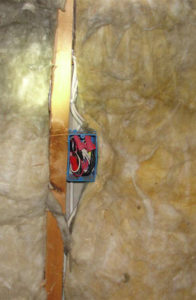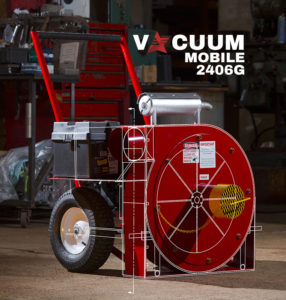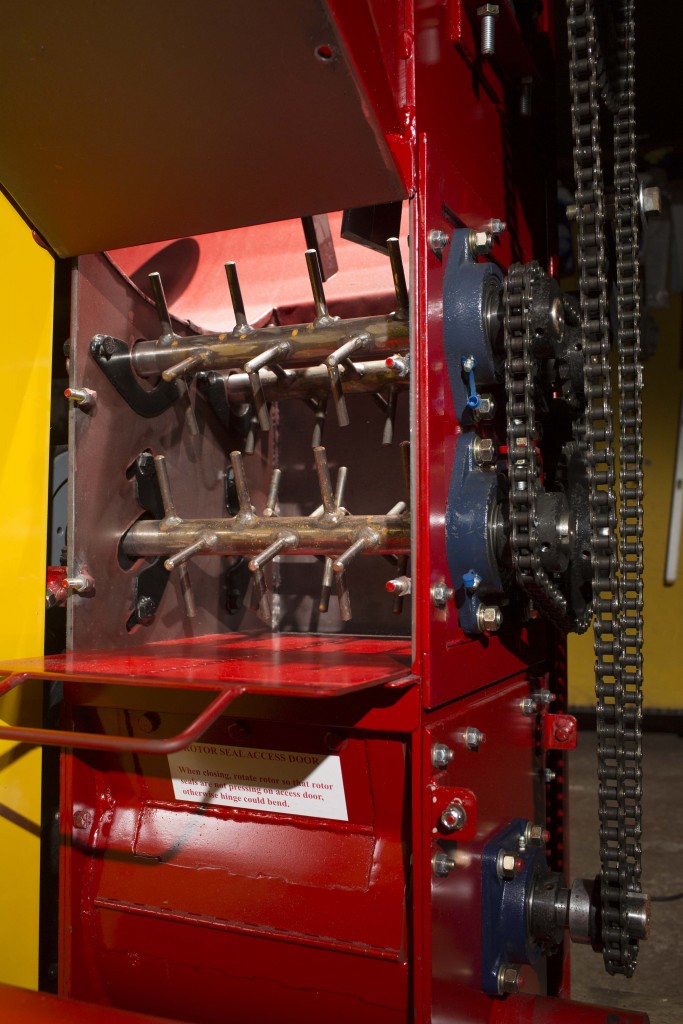Quality Leads to Quantity
July 10, 2017
Every Star Machine is built with a Genuine Honda® Engine unless a customization for a diesel or electric motor is requested.
We choose Honda for their superior quality, reliability and performance. When we designed our range of Star Machine Insulation Blowers, we had the same core values in mind – our insulation blowers need to be reliable, last a long time, be able to take a beating, and continue to perform consistently every day, at every job.
We use three different Honda® Engines in our insulation machines, staring with the GX 390, a 13.5 HP engine with a 6.4 U.S. quart fuel tank – this feisty little engine powers our 1304G Mobile Insulation Vacuum and the MiniStar 1213 Insulation Blower, making this the little engine that could. This small, powerful engine enables our smaller vacuum to be the impressive starter insulation removal tool that it is, and the MiniStar 1213 the powerful, yet compact insulation blower for any small to medium job you have at hand. The MiniStar 1213 has an impressive output of 2800 lbs/hour in cellulose and 1200 lbs/hour in fiberglass insulation for its small footprint of only 35” by 60”.
We then bump the power up a bit as we transition into the Honda® GX 630, a 20 HP engine that we use in the FiberStar 1620, and the SuperStar 1620 insulation blowers. For these larger capacity, larger production machines we have paired this engine with a 6 U.S. Gallon portable fuel tank to allow for easy and fast refueling. This increase in power enables these two insulation blowing machines to significantly increase production to 4000 lbs/hour in cellulose and 2000 lbs/hour in fiberglass.
Finally, we reach the 24 HP Honda® GX 690 Engine that powers our 2406G Mobile and Mounted Insulation Vacuums and the SuperStar Supreme 2024 Insulation Blower. These are our most powerful standard order machines and are the most popular models with professional insulation contractors, drywall contractors, and many more. The SuperStar Supreme 2024 insulation blower offers intense production levels of over 4700 lbs/hour in cellulose, and 2300 lbs/hour in fiberglass insulation.
To learn more about these powerful, Honda® driven insulation machines, check them out here!
Attention to Detail: Bulk Insulation Removal
June 27, 2017
Removing old or damaged insulation from a home has never been a pleasant job, but someone’s gotta do it. Thankfully, we have made that job much easier with the Star Machine 2406G Mobile Insulation Vacuum.
With a 24-HP Genuine Honda Engine, and a 6” inlet, this insulation vacuum is capable of removing entire batts of insulation (dependant on thickness), and saves bagging time and saves hundreds of trips back and forth from the attic space to the dumpster or trailer. Your crew member can now stay in the attic space and easily vacuum the old or damaged insulation material.
A key to the high-performance of the 2406G Mobile Insulation Vacuum, and our other insulation vacuums starts with the intense attention to detail during the design stage. We analyzed how material flows through the vacuum, and took note of where the collection points were within the impeller housing. We then offset the impeller to allow more space within its housing where more space was needed to prevent binding, and keep the material flowing smoothly. This not only allows for continuous suction, but also more effectively shreds the material that is being removed.
We didn’t stop at the placement of the impeller when analyzing material flow, we looked at the outlet too. We have welded a taper from the top of the impeller housing down to the 6” outlet tube to ensure that we limit rough edges and corners that could slow the flow of material. This taper keeps everything moving along, and funnels all material from the impeller housing out to the outlet hose.
Batt Insulation, Bad Insulation?
June 22, 2017

Gaps in FIberglass Batt Insulation
Batt insulation has been incredibly popular in North America for decades, it is inexpensive, and has a reasonable R-Value. However, there are a few issues with batt insulation that make it less than the ideal material for most applications.
Batt insulation is often installed improperly, even by professionals. When fiberglass batt insulation is compressed it loses its insulating abilities, and becomes much less effective in keeping your home/building tight.
Fiberglass batt insulation also tends to have gaps between the insulation and the walls of the cavity that it is supposed to insulate. If there is not contact on all six sides of the cavity that a batt is in, then there are many small sections of that cavity that are not insulated at all.
The alternative is blown-in insulation, we prefer cellulose insulation for this such as GreenFiber Insulation for its ability to be densely packed inside a closed wall cavity which stops air leakage, and ensures that every nook and cranny of the cavity is insulated.
Every Star Machine Insulation Blower is capable of densely packing cellulose insulation into a closed wall cavity, thanks to the powerful blowers that we install in every Star Machine. These blowers help in speeding up production in all insulating tasks, from open-blow attic installations to controlled retrofit wall cavity applications.
Maintaining Your Star Machine Insulation Blower: How to Take Care of the Machine that Takes Your Business to the Next Level
April 10, 2017
Whether you are blowing cellulose, fiberglass or rock wool loose insulation, your machine will need some general maintenance as it goes to job after job with you.
Cellulose insulation is the easiest on the machine as it is less abrasive and easier to break up. Fiberglass and rock wool insulation will be more work for your auger, shredders, and air seals, but we build these insulation machines to handle all of those materials. Our insulation blowers are built with the most reliable air seals of any insulation machine on the market, they can last last for years of heavy use with various insulation materials.
When loading your Star Machine insulation blower be sure you do not over load or jam compressed chunks of insulation material into the hopper in a way that doesn’t allow the auger to start breaking it up and feeding it down to the shredder.
Moving along down with the flow of the insulation, the shredders are built to last and take whatever is thrown at them. If you have gone with the Four Finger Shredder System Upgrade, then you will have a better material yield for large open blow insulation jobs in attics and other similar spaces. Occasionally foreign objects will get into the shredder, breaking or bending the steel fingers. Should it become necessary to replace these fingers it can be accomplished at any good machine-shop.
The feeder of your machine contains a five or six-vane rotor with “seals” on the sides and ends of each blade. Under normal usage these seals will last a minimum of six months. Occasionally, however, they might break or excess shot in the material cause them to wear faster. Whenever you experience blowback up through the shredder or the material fails to feed down properly it is an indication that the seals need replacing.
With all of that said, we build our Star Machine insulation blowers to a standard that is not reached by your other options. Every piece is hand made and welded. We use a ¼” steel construction to ensure the machine will last.
Spoiled for Choice: Exploring the Benefits of Different Types of Blown Insulation Material
March 10, 2017
Blown-in insulation is a great option for attics and wall cavities for it’s loose fill and dense pack capabilities (dependant on the application and location). The fibers can settle into small spaces that would otherwise require a significant renovation to access for other methods of insulation such as batts or spray foam.
There are three types of insulation that are typically used for blown-in applications – cellulose, fiberglass, and rockwool insulation. There are pros and cons to each type of insulation, check out the comparison below.
|
|
Cellulose |
Fiberglass |
Rock Wool |
|
R-value/inch |
3.2–3.8 |
2.2–2.7 |
3.0–3.3 |
|
Inches needed for R-20 |
5.25”-6.25 |
7.4”-9” |
6”-6.6” |
|
Inches needed for R-50 |
13.3”-15.6” |
18.5”-22.7” |
15.1”-16.6” |
|
Density in lb/ft3 |
1.5–2.0 |
0.5–1.0 |
1.7 |
|
OK for 1/2" drywall, 24" on center? |
No |
Yes |
No |
|
OK for 1/2" drywall, 16" on center? |
Yes |
Yes |
Yes |
|
OK for 5/8" drywall, 24" on center? |
Yes |
Yes |
Yes |
Cellulose Insulation:
Cellulose insulation is made up of 80% to 100% recycled content containing shredded newsprint. It is non-toxic, and generally local – there are many cellulose manufacturers across North America. Cellulose insulation is an excellent choice for attic spaces, it can be blown to whatever depth is required as long as proper ventilation is installed, as cellulose also has an air sealing effect that other materials such as fiberglass and rockwool do not achieve.
Cellulose is also a great choice for dense packing into wall cavities, as it is fire and insect resistant. The only concern for cellulose is it should be used in dry areas of the home, so a moist basement is not a good place to use this choice.
Fiberglass Insulation:
Fiberglass insulation is made up of roughly 20% recycled materials containing recycled glass and sand that is melted together and then manufactured into a wool-like material that traps air between the fibers to create an insulating layer. Fiberglass insulation is known to cause irritation on the skin and eyes when in contact with the material. When blowing fiberglass insulation, it is recommended that all skin be covered and a respirator/full face mask be worn to prevent irritation and inhalation of the fibers.
Fiberglass works much in the same way as cellulose in that it’s loose fibers fill in the area to be insulated and provide a layer of insulation. Fiberglass however does not stop air flow in the same way that cellulose does, since it is lighter, and requires air space between the fibers to provide the insulating properties.
Rock Wool Insulation:
Rock wool insulation is made up of at least 75% industrial waste, and up to 90% recycled content. It is made from thin strands or fibers of what was molten rock. This gives it amazing fire proofing capabilities and it is a hydrophobic material, meaning it will not absorb water, and will maintain it’s R-Value once it dries again.
Rock wool suffers from the same clumping issues as fiberglass insulation can when not properly shredded before being blown, but it offers more comfort to the installer in that it doesn’t pose the same health risks when installing it as fiberglass.
Conclusion:
The types of insulation that you are using on your jobs will likely depend on the location and application of the material in each building that you are working on; but one thing you know will be consistent between jobs is that your Star Machine Insulation Blower will get the job done and leave you ready for the next job faster than your other options. Check out our full line up of insulation machines at www.starmachineltd.com, or give us a call at 1-877-782-7883.
Maximize your Yield: How to Get More Out of Each Bag of Insulation
February 17, 2017
Fiberglass is one of the most popular choices for blown-in insulation in homes and buildings across North America – it has been used for decades now and is one of the most trusted products on the market. Blown-in insulation is a great, affordable option for retrofit and renovation jobs because it is fairly non-invasive in the home; but blown-in insulation is also a great option for many applications in new home construction, with a strong argument for attic insulation being a very fast way to get an entire attic space properly insulated in a very short time period.
When working with fiberglass insulation, it is especially important to make sure your insulation blower is properly separating and shredding the material. An issue that many insulators will run into at some point during their careers is a phenomenon referred to as ‘The Snowballing Effect’. This is the clumping of fiberglass insulation into small balls that occurs during the insulation blowing process, it is caused for the most part by ineffective shredding methods that fail to properly pull the materials apart from each other before they are blown through the hose.
All Star Machine Insulation Blowers come standard with a Two Finger Shredder System that works to separate cellulose insulation perfectly, and even does a very good job with fiberglass and rockwool. With that said, we offer an upgrade to really maximize your fiberglass insulation yield – the Four Finger Shredder System has a total of four arms that have carefully positioned 3/8” steel fingers that tear into, pull apart and shred the fiberglass insulation to stop the Snowballing Effect and to get the most out of each bag of insulation you use.
With the Four Finger Shredder System, insulation contractors have seen up to a 10% increase in their yield. Imagine being able to use 10% less insulation on each job while still properly insulation each space. By properly shredding and aerating the insulation with the Four Finger Shredder System you stop the clumps and mix more air into the insulation, actually providing a better insulating layer, and saving on material at each job.
When you go to choose your next insulation blower, or insulation machine just keep in mind that with one small investment in that upgrade, you can save on insulation for the entire life of that machine – you’d be paying yourself back with those insulation savings in no time.
If you have any questions about the Four Finger Shredder System or one of our insulation machines, just give us a call at 1-877-782-7883.



